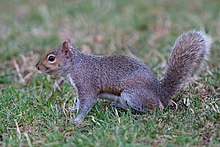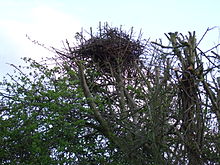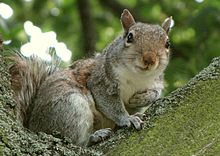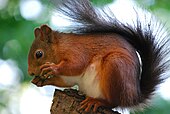Eastern gray squirrel
| Eastern gray squirrel | |
|---|---|

| |
| Eastern gray squirrel in Washington, D.C. | |
| Scientific classification | |
| Kingdom: | |
| Phylum: | |
| Class: | |
| Order: | |
| Family: | |
| Genus: | |
| Subgenus: | |
| Species: | S. carolinensis
|
| Binomial name | |
| Sciurus carolinensis Gmelin, 1788
| |
| Subspecies[2] | |
| |

| |
| Range in red (excludes introduced populations) | |
| Synonyms | |
|
Matecumbei, Minutus, Hiemalis, Leucotis, Migratorius | |
The eastern gray squirrel or grey squirrel (depending on region) (Sciurus carolinensis) is a tree squirrel in the genus Sciurus native to the eastern and midwestern United States, and to the southerly portions of the eastern provinces of Canada. The native range of the eastern gray squirrel overlaps with that of the fox squirrel (Sciurus niger), with which it is sometimes confused, although the core of the fox squirrel's range is slightly more to the west.
A prolific and adaptable species, the eastern gray squirrel has been introduced to, and thrives in, several regions of the western United States. It has also been introduced to Britain, where it has spread across the country and has largely displaced the native red squirrel, Sciurus vulgaris. In Ireland, the red squirrel has been displaced in several eastern counties, though it still remains common in the south and west of the country.[3] There are concerns that such displacement might happen in Italy and that gray squirrels might spread from Italy to other parts of mainland Europe.[4]
Etymology
The genus, Sciurus, is derived from two Greek words, skia, meaning shadow, and oura, meaning tail. This name alludes to the squirrel sitting in the shadow of its tail.[5] The specific epithet, carolinensis, refers to the Carolinas, where the species was first recorded and where the animal is still extremely common. In the United Kingdom and Canada, it is simply referred to as the "grey squirrel".
Description

As the name suggests, the eastern gray squirrel has predominantly gray fur, but it can have a brownish color. It has a white underside and a large bushy tail. Particularly in urban situations where the risk of predation is reduced, both white- and black-colored individuals are quite often found. The melanistic form, which is almost entirely black, is predominant in certain populations and in certain geographic areas, such as in large parts of southeastern Canada. Genetic variations within these include individuals with black tails and black-colored squirrels with white tails (see Tree squirrel for more information on these color variations).
The head and body length is from 23 to 30 cm (9.1 to 11.8 in), the tail from 19 to 25 cm (7.5 to 9.8 in) and the adult weight varies between 400 and 600 g (14 and 21 oz).[6][7]

The tracks of an eastern gray squirrel are difficult to distinguish from the related fox squirrel and Abert's squirrel, though the latter's range is almost entirely different from the gray's. Like all squirrels, the eastern gray shows four fingers on the front feet and five on the hind feet. The hind foot-pad is often not visible in the track. When bounding or moving at speed, the front foot tracks will be behind the hind foot tracks. The bounding stride can be two to three feet long.[8]
Behavior
Like many members of the family Sciuridae, the eastern gray squirrel is a scatter-hoarder; it hoards food in numerous small caches for later recovery.[1] Some caches are quite temporary, especially those made near the site of a sudden abundance of food which can be retrieved within hours or days for reburial in a more secure site. Others are more permanent and are not retrieved until months later. Each squirrel is estimated to make several thousand caches each season. The squirrels have very accurate spatial memory for the locations of these caches, and use distant and nearby landmarks to retrieve them. Smell is used once the squirrel is within a few centimeters of the cache.[citation needed]
Squirrels have been known to pretend to bury the object if they feel that they are being watched. They do this by preparing the spot as usual, for instance digging a hole or widening a crack, miming the placement of the food, while actually concealing it in their mouths, and then covering up the "cache" as if they had deposited the object.[9][10]

Squirrels carry their food in their mouths, and every few steps they stop and look either to either right or left, alternating every stop. It is speculated that it does this to protect itself and be aware of its surroundings because it is a highly preyed upon mammal. [11]
The eastern gray squirrel is one of very few mammalian species that can descend a tree head-first. It does this by turning its feet so the claws of its hind paws are backward pointing and can grip the tree bark.[citation needed] To climb the tree, the squirrel stands on its back legs and uses its front legs to attach itself onto the trunk of the tree.[2]

Eastern gray squirrels build a type of nest, known as a "drey", in the forks of trees, consisting mainly of dry leaves and twigs. Males and females may share the same nest for short times during the breeding season and during cold winter spells squirrels may share a drey to stay warm. They may also nest in the attic or exterior walls of a house, where they may be regarded as pests, and as fire hazards due to their habit of gnawing on electrical cables (see Tree squirrel for more on interactions with humans). In addition, squirrels may inhabit a permanent tree den hollowed out in the trunk or a large branch of a tree.[12]
Eastern gray squirrels are crepuscular,[7] or more active during the early and late hours of the day, and tend to avoid the heat in the middle of a summer day.[12] They do not hibernate.[13]
Predators include humans, hawks, weasels, raccoons, domestic and feral cats, snakes, owls, and dogs.[12]
Reproduction

Eastern gray squirrels breed twice a year, December to February and May to June, though this is slightly delayed in more northern latitudes.[7][12] The first litter is born in February to March, the second in June to July. Normally, two to six young are born in each litter, but this number can be as high as eight. The gestation period is about 44 days.[12] The young are weaned at seven weeks and leave the nest after 10 weeks.
Eastern gray squirrels can start breeding as early as five and a half months old,[12] but usually breed for the first time at the age of one.[14] These squirrels can live to be 20 years old in captivity, but in the wild usually only live up to 12.5 years.
Communication
As in most other mammals, communication among eastern gray squirrel individuals involves both vocalizations and posturing. The species has a quite varied repertoire of vocalizations, including a squeak similar to that of a mouse, a low-pitched noise, a chatter, and a raspy "mehr mehr mehr". Other methods of communication include tail-flicking. Communications are mainly used in mating season and to ward off predators.[citation needed]

The use of vocal and visual communication has been shown to vary by location, based on elements such as noise pollution and the amount of open space. For instance, populations living in large cities generally rely more on the visual signals, due to the generally louder environment with more areas without much visual restriction. However, in heavily wooded areas, vocal signals are used more often due to the presence of less noise and a dense canopy restricting visual range.[citation needed]
Diet

Eastern gray squirrels eat a range of foods, such as tree bark, berries, many types of seeds and acorns, walnuts, and other nuts, and some types of fungi found in the forests, including fly agaric mushrooms (Amanita muscaria).[11] They can cause damage by tearing the tree bark and eating the soft cambial tissue underneath: sycamore (Acer pseudoplatanus) L. and beech (Fagus sylvatica L.) suffer the greatest damage.[15]

Eastern gray squirrels have a high enough tolerance for humans to inhabit residential neighborhoods and will raid bird feeders for millet, corn, and sunflower seeds. On very rare occasions, when their usual food sources are scarce, eastern gray squirrels will also prey upon insects, frogs, small rodents including other squirrels, and small birds, their eggs and young.[1][16] They will also gnaw on bones, antlers, and turtle shells – likely as a source of minerals sparse in their normal diet.[11]
Habitat
In the wild, eastern gray squirrels can be found inhabiting large areas of mature, dense woodland ecosystems, generally covering 40 hectares of land.[16] These forests usually contain large amounts of dense understory vegetation that provides them sufficient amount of food sources and favorable shelters. Oak-hickory hardwood forests are preferred over coniferous forests.[7]
Eastern gray squirrels generally prefer constructing their dens upon large tree branches and within the hollow trunks of trees. They also have been known to take shelter within abandoned bird nests. The dens are usually lined with moss plants, thistledown, dried grass, and feathers. These perhaps provide and assist in the insulation of the den, used to reduce heat loss. A cover to the den is usually built afterwards.[citation needed]
Close to human settlements, eastern gray squirrels are found in parks and back yards of houses within urban environments and in the farmlands of rural environments.[17]
Distribution

The eastern gray squirrel is found in the eastern United States and adjacent southern Canada; New Brunswick to Manitoba, south to East Texas and Florida.[1] It has also been introduced into Ireland,[18] Britain, Italy, South Africa, and Australia (where it was extirpated by 1973).[1]
Introductions
The eastern gray squirrel has been introduced to a variety of locations in western North America: in Canada, to the southwest corner of British Columbia and to the city of Calgary, Alberta;[19] in the United States, to the states of Washington and Oregon and, in California, to the city of San Francisco and the peninsula area of San Mateo and Santa Clara Counties, south of the city. It has become the most common squirrel in many urban and suburban habitats in western North America, from north of central California to southwest British Columbia. At the turn of the 19th to 20th centuries, the eastern gray squirrel was introduced into South Africa, Ireland and England.

In South Africa, though exotic, it is not usually considered an invasive species owing to its small range (only found in the extreme southwestern part of the Western Cape, going north as far as the small farming town of Franschhoek), as well because it inhabits urban areas and places greatly affected by humans, such as agricultural areas and exotic pine plantations. Here, it mostly eats acorns and pine seeds, although it will take indigenous and commercial fruit, as well.[20] Even so, it is unable to use the natural vegetation (fynbos) found in the area, a factor which has helped to limit its spread.[21] It does not come into contact with native squirrels due to geographic isolation (a native tree squirrel, Paraxerus cepapi, is found only in the savanna regions in the northeast of the country)[22] and different habitats.
It spread rapidly across England and then became established in both Wales and parts of southern Scotland. On mainland Britain, it has almost entirely displaced the populations of native red squirrels. On the island of Ireland, this displacement has not been as rapid because there was only a single introduction, in County Longford. Schemes have been introduced to control the population in Ireland to encourage the native red squirrels. Eastern gray squirrels have also been introduced to Italy, and the European Union has expressed concern it will similarly displace the red squirrel from parts of the European continent.
Displacement of red squirrels
In the United Kingdom and in Ireland, the eastern gray squirrel has few natural predators. This has aided its rapid population growth and has led to the species being classed as a pest. Measures are being devised to reduce its numbers, including one plan for celebrity television chefs to promote the idea of eating the squirrels.[23] In areas where relict populations of red squirrel survive, such as the islands of Anglesey and Brownsea, programs seeking to eradicate pest squirrels are in progress in an effort to allow red squirrel populations to recover.[24]

Although complex and controversial, the main factor in the eastern gray squirrel's displacement of the red squirrel is thought to be its greater fitness and, hence, a competitive advantage over the red squirrel on all measures.[25] The eastern gray squirrel tends to be larger and stronger than the red squirrel and has been shown to have a greater ability to store fat for winter. The squirrel can therefore compete more effectively for a larger share of the available food, resulting in relatively lower survival and breeding rates among the red squirrel. Parapoxvirus may also be a strongly contributing factor; red squirrels are fatally affected by the disease, while the eastern gray squirrels are unaffected but thought to be carriers. The red squirrel is also less tolerant of habitat destruction and fragmentation which has led to its population decline, while the more adaptable eastern gray squirrel has taken advantage and expanded.
Similar factors appear to have been at play in the Pacific region of North America, where the native American red squirrel has been largely displaced by the eastern gray squirrel in parks and forests throughout much of the region.
Ironically, "fears" for the future of the eastern gray squirrel arose in 2008, as the melanistic form (black) began to spread through the southern British population.[26][27] In the UK, if a "grey squirrel" (eastern gray squirrel) is trapped, under the Wildlife and Countryside Act 1981, it is illegal to release it or to allow it to escape into the wild; instead, it should be humanely destroyed.[28]
As food
Gray squirrels were eaten in earlier times by native Americans. Today, it is still available for human consumption and is occasionally sold in the United Kingdom.[29]
See also
References
- ^ a b c d e Template:IUCN2008
- ^ a b Thorington, R.W., Jr.; Hoffmann, R.S. (2005). "Sciurus (Sciurus) carolinensis". In Wilson, D.E.; Reeder, D.M (eds.). Mammal Species of the World: a taxonomic and geographic reference (3rd ed.). The Johns Hopkins University Press. pp. 754–818. ISBN 0-8018-8221-4. OCLC 26158608.
{{cite book}}: External link in|chapterurl=|chapterurl=ignored (|chapter-url=suggested) (help)CS1 maint: multiple names: authors list (link) - ^ Carey, M., Hamilton, G., Poole, A., and Lawton, C. The Irish Squirrel Survey 2007. COFORD, Dublin – Report can be downloaded from www.coford.ie
- ^ "Summary". Europeansquirrelinitiative.org. Retrieved 2010-06-10.
- ^ Hamilton, H. (1990). Smith, D. (ed.). Eastern Grey Squirrel. Hinterland Who's Who. ISBN 0-660-13634-1. Retrieved 2008-11-18.
- ^ BBC: Science and Nature, "Grey squirrel: Sciurus carolinensis"
- ^ a b c d "Red & Gray Squirrels in Massachusetts". MassWildlife. Massachusetts Division of Fisheries and Wildlife. Retrieved 2012-04-03.
- ^ Murie & Elbroch, Peterson Field Guide to Animal Tracks, pg. 79 (2005)
- ^ Steve Grant, "The Squirrel's Bag Of Tricks: They Can't Get Out Of The Way Of Cars, But Other Behaviors Demonstrate Advanced Thinking (for A Rodent)", The Hartford Courant, October 21, 2004.
- ^ "Smart squirrels fool food thieves", BBC Home, Jan. 17, 2008; accessed 2012.08.21.
- ^ a b c Kim Long (September 1995). Squirrels: a wildlife handbook. Big Earth Publishing. p. 95. ISBN 978-1-55566-152-6.
- ^ a b c d e f Lawniczak, M. (2002). "Sciurus carolinensis". Animal Diversity Web. Retrieved 2008-07-10.
- ^ "Grey squirrel Advisory" (PDF). Retrieved 2008-07-10.
- ^ "Squirrels What is the life cycle of the grey squirrel?". Retrieved 2008-07-10.
- ^ Butler, F. and Kelleher, C.,(eds) 2012. All-Ireland Mammal Symposium 2009. Irish Naturalists' Journal, Belfast, 90pp ISBN 978-0-956704-1-1
- ^ a b "ADW: Sciurus carolinensis: Information". Animaldiversity.ummz.umich.edu. Retrieved 2010-06-10.
- ^ "The Leading America Zoo Site on the Net". americazoo.com. Retrieved 2011-10-30.
- ^ McGoldrick, M. and Rochford, J. 2009. Recent range expansion by the Grey Squirrel (Sciurus carolinensis Gmelin 1788) I. Nat. J. 30: 24-28
- ^ "Hinterland Who's Who - Eastern Grey Squirrel". Hww.ca. Retrieved 2010-06-10.
- ^ "The Grey Squirrel - Sciurus carolinensis of Southern Africa". Home.intekom.com. Retrieved 2010-06-10.
- ^ "Sciurus carolinensis (Grey Squirrel)". Biodiversityexplorer.org. Retrieved 2010-06-10.
- ^ "Tree Squirrel | Rodent | Southern Africa". Krugerpark.co.za. Retrieved 2010-06-10.
- ^ "Jamie 'must back squirrel-eating'". BBC News. 2006-03-23. Retrieved 2007-08-22.
- ^ "Red squirrel conservation, squirrel ecology and grey squirrel management". The Friends of the Anglesey Red Squirrels. Retrieved 2007-08-22.
- ^ Wauters, L. A., Gurnell, J., Martinoli, A., & Tosi, G. (2002). "Interspecific competition between native Eurasian red squirrels and alien grey squirrels: does resource partitioning occur?". Behavioral Ecology and Sociobiology. 52: 332–341.
{{cite journal}}: CS1 maint: multiple names: authors list (link) - ^ "Black squirrels set to dominate". BBC News. 2009-01-20. Retrieved 2011-10-30.
- ^ "The pack of mutant black squirrels that are giving Britain's grey population a taste of their own medicine". Daily Mail. London. 2008-04-26.
- ^ "Defra Rural Development Service Technical Advice Note 09" (PDF).
- ^ The Economist, Vol. 402 Number 8772; "Wild meat: Squirrel nutcase" http://www.economist.com/node/21548935
External links
- ARKive - Still photos and videos
- Squirrels are everywhere - Photo gallery of squirrels
- A brief history of the black squirrel at Kent State University
- Eastern Gray Squirrel Facts from Hinterland Who's Who
- An Exotic Evolution: Black Squirrels Imported in Early 1900s Gain Foothold - an article from The Washington Post
- WildlifeOnline - Natural History of Tree Squirrels
- Smithsonian Eastern Gray Squirrel article
- A high definition video of a young grey squirrel, filmed in the United Kingdom.
- IUCN Red List least concern species
- Sciurus
- Animals described in 1788
- Mammals of North America
- Mammals of Europe
- Mammals of the United Kingdom
- Fauna of the Republic of Ireland
- Fauna of the United States
- Invasive mammal species
- Non-native fauna of the British Isles
- Mammals of Great Britain
- Mammals of the United States
- Urban animals





